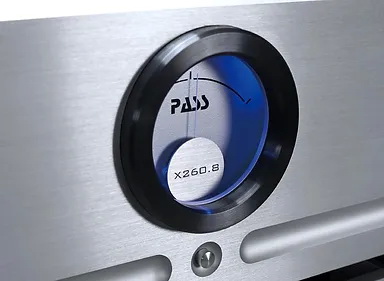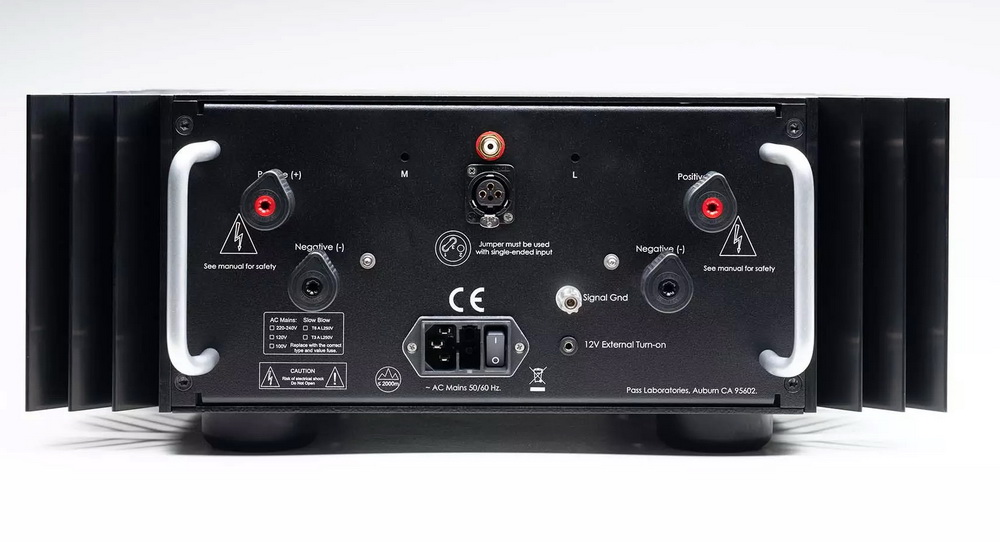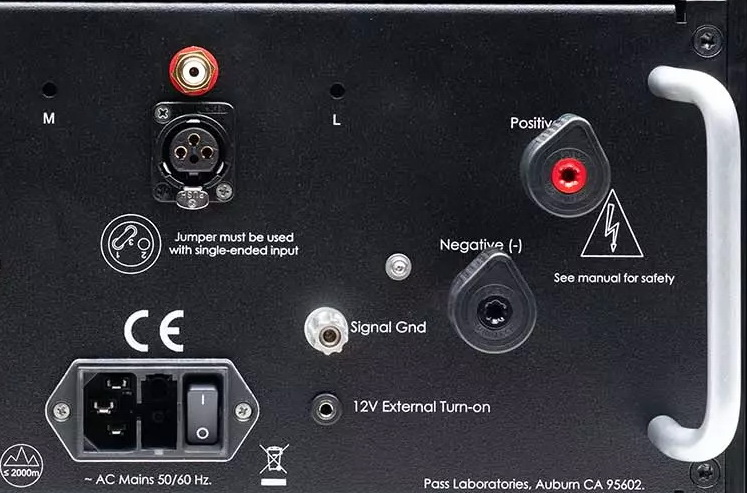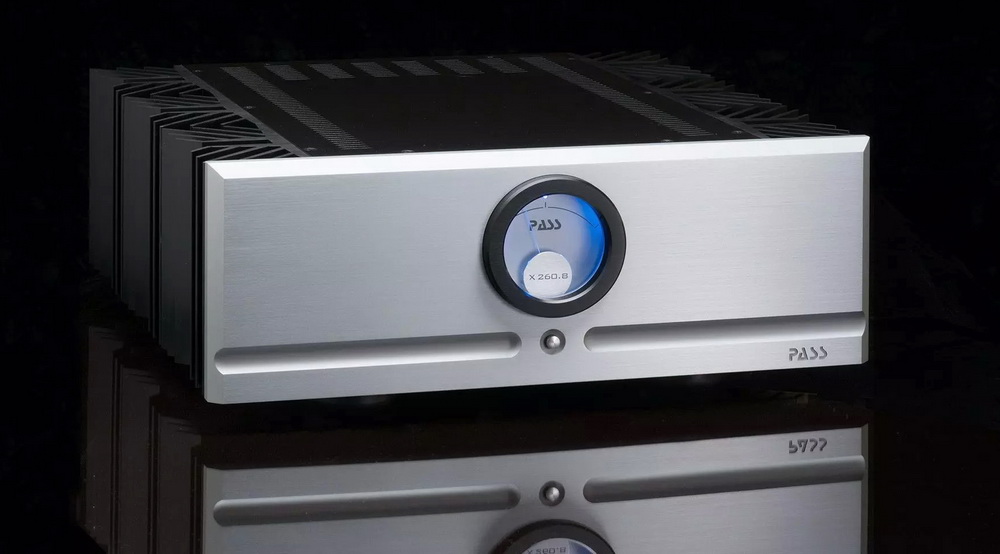Pass Labs X260.8 Monoblock Amplifiers
Well Mannered .... Time Tested Sound
I can already hear you asking, "Ken, why are you reviewing a product introduced in 2014?" Good question. It is rare to find an audio component design with a lifespan of over ten years in today's industry, and I am intrigued by the longevity of this product series. While much has been written about various Point 8 amplifiers and industry legend Nelson Pass, this review will cover the amplifier's sound quality and explore the reasons behind Pass Labs' enduring popularity.
Pass Labs products are highly esteemed by audiophiles, and Nelson Pass has made significant contributions to amplifier design and audio engineering, which have had a lasting impact on the industry and inspired contemporary and future audio technologies.
My long history with Nelson Pass designed products starts in 1975. At that time, I ran an audio store that was an early Threshold dealer. When we received our first Model 800A, we were impressed with the significant improvement in sound quality compared to the Crown and Phase Linear transistor amps we had in our lineup. Threshold became a mainstay in our product lineup for many years. Over the decades, I have had the opportunity to listen to or own quite a few of Nelson Pass's efforts, including his designs for Nakamichi and Adcom.
Here is a short history of Nelson Pass and Pass Labs.
Threshold Audio
· Before establishing Pass Labs, Nelson Pass co-founded Threshold Corporation in the mid-1970s.
· Pass developed the Stasis amplifiers at Threshold, which gained significant recognition for their innovative design and sound quality.
· The Stasis design utilized a unique feedback circuit that improved linearity and reduced distortion, setting a high standard for audio amplifiers.
Enter Pass Labs
· In 1991, Nelson established Pass Laboratories in Auburn, California, focusing on designing high-performance audio equipment following a minimalist design philosophy. Initially, the company focused on creating amplifiers, prioritizing sound quality through simplicity and innovation.
Key Products and Innovations
Aleph Series (1991-2000)
· The Aleph series marked Pass Labs' entry into the high-end audio market.
These amplifiers featured single-ended Class A designs, known for their warm, natural sound. The Aleph 0 amplifier was the first in the series, setting the tone for Pass Labs' design philosophy.
X Series (1998)
· The X series introduced the patented Supersymmetry™ (SuSy) circuit topology, which reduced distortion by canceling common-mode noise, resulting in cleaner, more accurate sound reproduction. The X amplifiers were highly praised for their transparency and dynamic performance.
XA Series (Early 2000s)
· The XA series combined the single-ended Class A operation of the Aleph series with the low distortion characteristics of the SuSy design.
· These amplifiers offered high power output with excellent sound quality and became a favorite among audiophiles.
Nelson Pass offers a series of writings on the Pass Labs website, many of which are quite technical and flew right over my zoology major's head. (zoology major?? What was I thinking!!??) However, reading them did give me an essential understanding of Nelson's philosophy on sound, which is summed up quite well in the Point 8 owner manual.
"For many years, there has been considerable faith that if we simply keep improving the measurements of components such as amplifiers then they will sound better. Initially this was truly the case – equipment was sufficiently flawed from an objectivestandpoint that better measurements matched up with subjective experience.
At some level of objective quality there started to be a disconnect, and some audiophiles began to lose the faith. One of the responses to this was to examine more exotic sources of distortion in the equipment while some others simply worked to continue to reduce the flaws that were already understood.
There's no doubt that some real progress resulted from these efforts, and now you can purchase products at reasonable prices which measure far better than the old stuff. But the disconnect between the customer's perceptions and the measurements persists, and there have been cases of state-of-the-art engineering resulting in economic failure, apparently because people didn't care for the sound.
Well, of course you are dealing with people, and that will complicate any endeavor. The customer wants what the customer wants.
I have heard arguments that audiophiles are irrational, that decisions are based on appearance or cost or advertising. Certainly there is plenty of that, and there have been plenty of blind tests that have demonstrated that "audiophiles can't hear the difference", at least in the context of that test.
But I don't think that's the whole story. My experience is that under the right conditions the customer can often hear the difference, and his observations are not to be ignored. First, it has to be acknowledged that the science of cognitive perception is still in itsinfancy, and the ear is not really a microphone and the brain is not a tape recorder. The data we do have on this subject is a little like quantum mechanics – we have to change our view to make sense of the illusions and paradoxes that accompany the interpretation of sensory input. With regard to amplifiers at least, I think we already have the measurement data inhand. The problem is in our failure to interpret it with respect to human perception.
This puts some emphasis back on listening tests - extensive long-term tests with reliable listeners and familiar equipment and environments. This is not a cheap and easy procedure. Even assuming that the listener(s) really can hear, we still have the vagaries of individual taste, and not a large population of qualified listeners and
systems. In the end, even if we can design around the perceptions of a small qualified listening panel, we are still inevitably aiming at a minority audience in the real world. That's OK with me – One percent of this market is still a lot of amplifiers. The thing is, I don't think the audiophile wants technical perfection. He wants to be happy. (I added the emphasis KR)
Look at it this way: In the market there are rows of bottled drinking water. Some are contaminated with natural mineral content and carbonated, some have sugarbased substances added, some have been harvested from glaciers. They all appear to be more expensive than gasoline. Where is the pure distilled water? Probably on the bottom shelf, possibly even elsewhere in the store. It seems to be the least popular, even if it is cheaper than gasoline."
In our industry, many people aim for "absolute sound perfection." Nelson, on the other hand, prioritizes creating products that people will actually enjoy listening to, even as he focuses on technical excellence. I believe this is crucial to understanding Pass Labs' success. It's important to note that both goals can be pursued simultaneously.

Point 8 series replaces the Point 5
The Point 8 series utilizes the Supersymmetry-MOSFET circuit that Pass has continually improved since its introduction in 2000 and biases its stages more deeply into the Class-A operating region. Higher power MOSFETs increase the amplifiers' Class-A operation envelope while running at fractions of their stated specs to enhance performance and reliability.
Additionally, the Supersymmetry design has been optimized in the Point 8 model amplifiers. Unlike the Point 5 line, where input specifications were the same regardless of power rating, the Point 8 series features tailored front ends for each model's output stage. This customization includes variations in size, voltage, bias current, and other factors, leading to enhanced output stage performance and a unique sound characteristic for each model.
This is important to understand as you decide what Pass Labs amp you may be interested in. For instance, if you listened to an X250.8 stereo amp and decided you liked the sound but needed more power, you would typically go with the X350.8. But because of the slightly different/optimized input circuit, the increase in power would not be the only change you would experience. This is where guidance from North American Sales and Support Manager Kent English is invaluable, as he knows the subtle characteristic variances of each model and can shepherd you through your decision process.
 The X260.8 monoblocks and some key features.
The X260.8 monoblocks and some key features.
The Pass Labs X260.8 showcases a sleek, modern design with clean lines and an industrial look. The front panel is elegantly simple, featuring a single power button, the round blue illuminated meter, and a subtle logo. Inside, the X260.8 features high-quality components, including custom transformers and capacitors, ensuring long-term reliability and superior performance. The components are housed in a robust aluminum chassis that offers durability and efficient heat dissipation. The construction is impeccable. Rated at 260 watts per channel at 8 ohms and capable of delivering significantly more power into 4 and 2 ohms, the X260.8 can easily handle very demanding speakers. It stays in Class A up to 34 watts.
The amplifier boasts a wide frequency response from 1.5 Hz to 100 kHz and has balanced (XLR) and unbalanced (RCA) inputs. Pass Labs highly recommends using the balanced XLR inputs for best results. It weighs 100 lbs. and generates a lot of heat, so you need to give it room to breathe.
The X260.8 Sound
Since hearing it at AXPONA this year, this song ("Liberty" from the album Liberty (available on a double LP set mastered by Daniel Krieger at SST but inexplicably it has no catalog number_ed.) has transfixed me and become a favorite. Make this the last song you listen to late at night on your system. Take a deep breath, exhale, and let it carry you away. Anette's haunting voice and the sense of space are captivating. Sometimes, the simplest things can be the most informative because they allow the revelation of very subtle details.
Typical of Pass Labs sound, the X260.8 builds the music from midrange to extremes. Nelson's emphasis on second harmonics is evident, resulting in an emotionally engaging and resolving midrange. Connected to my Acora SRC-2 speakers, it possessed a natural bloom that breathed life into the music. The X260.8 beautifully renders Anette's vocal inflections and their essential contributions to the song's meaning. The cello's body and the strings' vibration will touch you if you let it. The piano notes ring out in space throughout the song, decaying to the rear of the sound field. Then, the sax comes in with a richness and tonality that will freeze you. The balance of tone and timbre of instruments make for a compelling listening experience. Every detail is present, yet it never feels forced or artificial. The midrange is luscious, powerful, and inviting to listen to, creating a relaxed and welcoming atmosphere.
Brian Brombergs Brombo! The JB Project is a good test for bass definition and explosive drumming. When listening to Brombo! the X260.8 bass gave way slightly to the best I have heard in overall "grip" and start and stop control but retained impressive depth and rich, airy quality. The bass attack was more "rounded" and less dry and technical than what the recently reviewed Gryphon Diablo 333 produced. Moreover, when the bass and drums played together and the complexity increased, the instruments were less clearly separated.
The amp did generate huge scale and grandeur, making for an immersive experience. It remained consistently melodic, with a sense of drive and tempo that it retained even at high volumes, which produced a powerful visceral experience.
They call it swing music for a reason
Dynamics are my "on" button…Macro and Micro. In the past, when questioned about the sound of Pass Labs amplifiers, I have consistently described them as "polite." By that, I mean they don't exhibit flaws, and they stay within their intended performance parameters. I found the X260.8s to be consistent with that description. However, with that politeness comes a sense of subtle dynamic restraint, much like the amplifier doesn't want to make a mistake and so plays it safe.
Listening to the Tuxedo Junction track, I found myself wanting the music to have a bit more dynamic "swing". I am not talking about ultimate volume but more about the dynamic expressiveness of the flow of the music—the expressiveness of the instruments within the band—the kind that gets your foot tapping and has you directing the musicians. The tonal quality of the instruments was excellent, allowing me to easily separate trombones, trumpets, and saxophones in the brass section and almost count how many of each were present.
Nelson notes in his technical papers that his Pure Class A XA series amplifiers exhibit a wider dynamic range than the X series. These may be the next amps I need to audition from Pass Labs to get my "swing" fix.
On the other hand, if my priority were a transistor amp with tube-like density in the midrange, I would be at home with the Pass Labs X series.
The highs on Marcin's excellent "Kashmir" track were clean and had speed and extension with a wide-open quality, yet they did not sound etched or bright. It allowed me to listen to all the information in a relaxed yet involving manner. I never felt it lacked sparkle or shimmer. The guitar "knocks" had a distinct wood quality along with the resonance of the guitar body. Overall, the X260.8 leaned slightly to the warm side of neutral and played well with a wide range of musical genres, including rock recordings from the 1970s and 1980s. The X260.8's soundstage and imaging exhibited substantial width and depth that remained consistently stable throughout my audition time.
I am sensitive to how transistor amplifiers represent instruments and vocalists, many of which often result in a disembodied, ethereal effect described as emanating from a perfect black background. However, in practice, live music differs from that. The Point 8 series more closely simulates the characteristics of tubes, presenting a soundstage/image with tangible presence and vitality. It delivers a realistic spatial portrayal of instruments and vocalists and a feeling of substantive mass in their occupied space.
This is a defining characteristic of Pass Labs amplifiers I have heard over the years.

Odds and Ends
Auto standby
Considering the amount of wattage that X Series Pass Labs amps draw at idle (typically 1/3 of its rated power), I would like to see a circuit that would switch it into a low-power standby mode after a specific time with no signal present, much like my Plinius SA-103.
Rear handle location
While having rear handles is a welcome addition when wrestling with a 100lb amplifier, they did present an obstacle with some of the spade connector terminated speaker cables I tried.
Power cord
Many audiophiles leave the stock power cord in the box when they get a new component and never try it. In the case of the Pass Labs product, you would be doing yourself a disservice. Be sure to try the stock cord, which is quite capable and very neutral. Yes, you may ultimately find another cord with better synergy with your system, but you may not need to spend the money.
Conclusion
Pass Labs has, over the past decades, successfully executed a trifecta of qualities.
1) Long term reliability
The company is known for the robust construction and reliability of its products, ensuring long-lasting performance.
2) Excellent customer support
Pass Labs takes pride in its ability to maintain older designs, which protect the customer's investment.
Pass Labs focuses on maintaining strong customer relationships, offering excellent service, support, and guidance.
3) Timeless design with pride of ownership.
Pass Labs Products' overall aesthetic designs stand the test of time and never feels "dated." Their reputation for reliability and continued serviceability keeps resale value high.
When you combine these three factors with the excellent sound quality provided by Nelson's innovative designs, you begin to understand why Pass Labs holds the esteemed position it maintains in the industry and earns the respect and support of so many Pass Labs owners, past and present.
It may sound like a simple formula to execute but achieving such "simplicity" has eluded many manufacturers in our industry, resulting in their ultimate extinction.
The X260.8 meets Nelson's aim of producing an amplifier that customers will genuinely enjoy using and listening to. Its technical prowess, construction quality, and musical balance position it in the upper echelon of available audio components. I can easily envision these amplifiers demanding several times their listed price.
In an industry where "luxury pricing" has gained a foothold, the X260.8, while not inexpensive, is a product who's excellent quality is not "luxury priced."
Price: $14,250/pair $15,250/pair in black
Q & A With Pass Labs President Anastasia Protopappas
KR: I have enjoyed our conversations over the past two years at various Audio Shows and would like readers to know more about you and Pass Labs' direction moving forward.
You became President of Pass Labs in January 2022, coming from Oracle, where you were a Senior Finance Manager... correct?
AP: Yes, Correct.
KR: I think readers would be interested to know the serendipity that precipitated your move and how you connected with Pass Labs to land there.
AP: My family has been working in the audio industry my whole life. My mother worked with Nelson at ESS and accepted the position to be Threshold's bookkeeper the day she found out she was pregnant with me. While I was growing up, my mom and stepdad (Joe and Barbara Sammut) worked for Krell and Krell Digital. I took my own path out of college and worked in corporate finance for almost 20 years. In 2019, I wasn't loving my job and my mom, who is a partner in Pass Labs, was lamenting wanting to retire. The stars aligned, and I came to work for Pass Labs to take over her role. As I spent time here taking on more and more responsibilities, Nelson, Desmond, and Wayne decided to make me President. There is a running joke that the role is not an honor necessarily but rather more like a hot potato that gets passed around. I take it as an honor, though, and am thoroughly loving the role!
KR: Since taking the helm at Pass Labs, what has been your primary focus, and how do you see it shaping the company's future?
AP: I think my primary focus changes and evolves with the needs of the business. When I started, I was focusing internally and making sure our production team was running well and felt supported and included in making Pass Labs a great place to work. We have several employees who have been with Pass for more than 20 years. Several of our folks are Threshold veterans. And several of us are second generation working for Nelson. It is important that all that institutional knowledge gets disseminated across the team.
Next came focusing on supply issues and building an inventory that could shorten our lead times.
Now, it is keeping all that in place and looking towards the future.
KR: At the Florida Audio Expo 2022 where we first met, we talked about you smoothing out the supply-side issues, as Pass, like everyone else, was impacted by COVID-19 supplier issues.
I suspect that has improved, and the lead times for products have shrunk.
What is the current lead time for most Pass Labs products?
AP: Generally speaking, our lead time is usually less than a month.
KR: I know everyone reading wants to know if there is a replacement for the Point 8 series in the near future.
AP: We have nothing to announce at this time.
KR: With Mark Sammut's retirement and the closing of Reno Hi-Fi, a well-known outlet for used and new Pass Labs and First Watt products, many readers wonder how that void will be filled.
You announced the Suncoast Audio Powered by Pass program this year.
Can you describe your vision for this new program and expand on how you see it growing the marketplace and the importance of having an outlet for used Pass Labs products to give past customers an avenue to trade in their Pass Labs components to upgrade?
AP: Audio customers love to have a path to upgrade and evolve their systems. We love that Suncoast Audio is providing that path. It is widely known that we continue to support all the products that we have ever produced (with only a few exceptions because we simply can't get parts for repair). The Powered by Pass program includes factory recertification. We value our used product customers just as much as our new product customers. Once a customer has experienced the fantastic service and support we provide, I believe more often than not, they will be our customers for life. You can't get better press than that!
The other part of Powered by Pass is an in home demo. I absolutely see this as a huge advantage for customers to get to hear our products in their own systems, in their own rooms before fully committing. Suncoast does a great job of understanding synergies of audio components and can steer their customers to the right combination, but sometimes hearing it for yourself is the best way to be convinced.
Several other domestic dealers do take trade in product as well - including but not limited to Refined Audio, Katli Audio and USA Tube Audio. And we do encourage other dealers to provide similar services as well and are always willing to support them in these endeavors.
KR: What can readers expect regarding the future of Pass Labs under your leadership?
AP: My mission is to make sure that Pass Labs keeps making great audio amplifiers and preamplifiers using Wayne and Nelson's unique skill sets to our greatest advantage. I want Pass Labs to continue to be the leader in customer service for the high end audio industry. And last but not least, I want Pass Labs to be a great place to work for our employees so they feel valued, included and continue to grow throughout their careers.
KR: Thank you for your time.
Review system:
Turntable: AMG Viella V12 JT
Cartridges: Micro Benz LP-S, Grado Statement 3
Phono Stage: Tom Evans Groove + SRX MK2.5
CD Transport: Jays Audio CDT-3 MK3, McCormack SST-1
Preamp: SMc Audio VRE-1C, VAC Master w/ phono option
Amplifier: SMc Audio GT23 DNA 0.5 Monoblocks
Digital: Innuos Zenith Mk III, Phoenix USB, and PhoenixNET, Mojo Audio Mystique X SE NC DAC
Speakers: Acora Acoustics SRC-2, REL S/510 six-pack
Tape: Crown CX 822 and SX 824
Cables: Belden Iconoclast, Cardas, SilverSmith Fidelium, Genesis Absolute Fidelity,
Shunyata
Accessories: Stillpoints Apertures and Ultra 2's, Kirmuss KA-RC-1, Wally Tools
Cartridge setup gear
Power: Shunyata Denali 6000/T v2, Typhon T2
Specifications
Specifications:
Class AB
Type Mono
Gain (dB) 26
Full Pwr @ 26 dB gain (V) 2.2
Low Frequency Response 1.5 Hz
High Frequency Response 100 KHz
Power Output /ch (8 ohm) 260
Input Impedance (SE & BAL Kohms) 50/100
Damping Factor 150
Power Consumption @ Idle (Watts) 370
Unit Dimension (W x D x H)(In.) 19 x 21.25 x 7.5
Unit Weight (LBS) 100
Manufacturer Information
Website Pass Labs
Pass Laboratories
13395 New Airport Road, Ste G
Auburn, CA 95602
(530) 878-5350










































.png)








